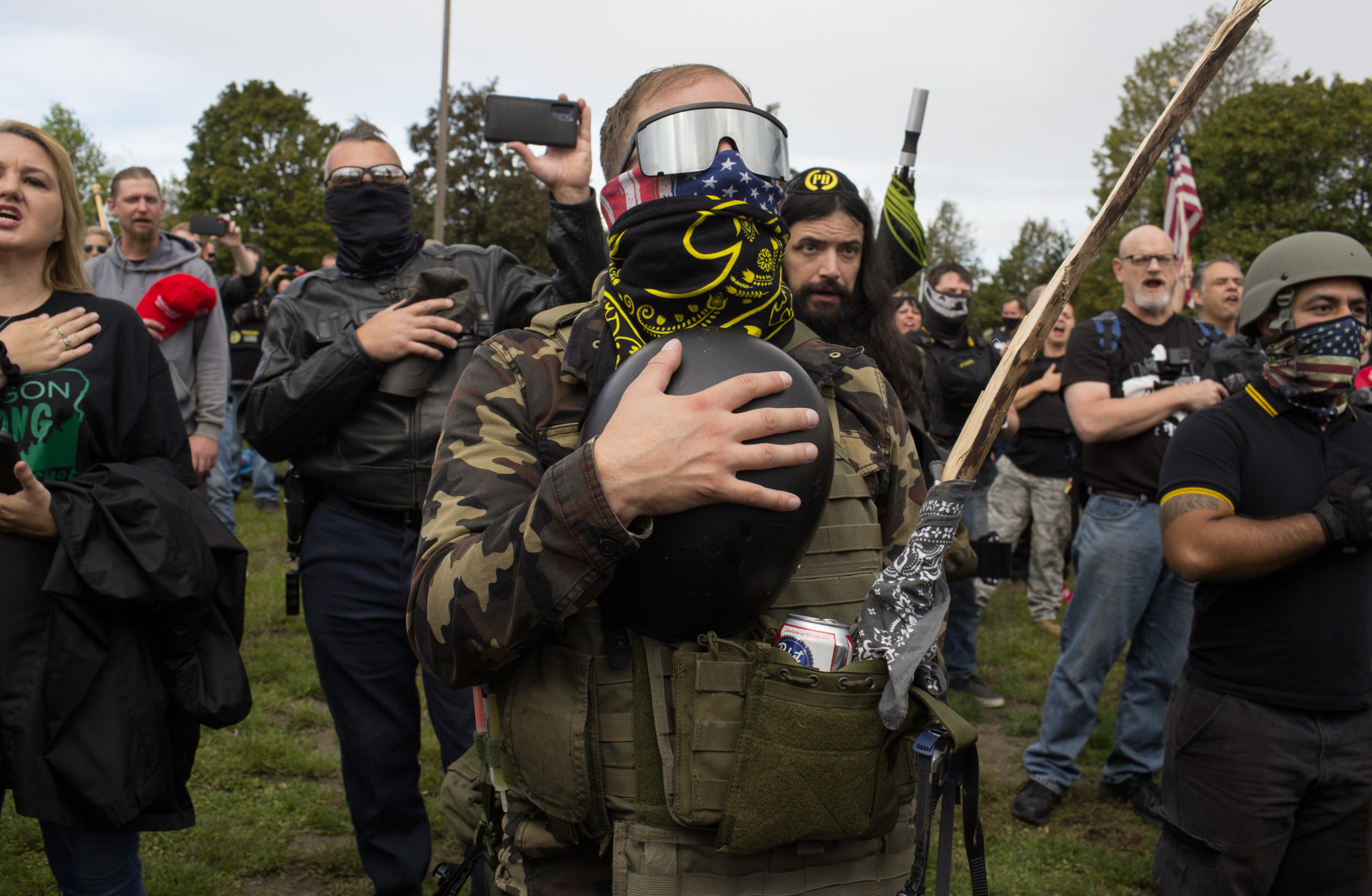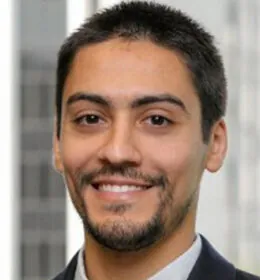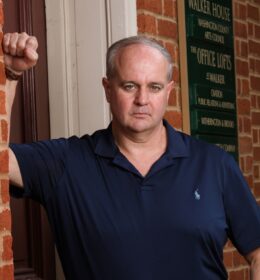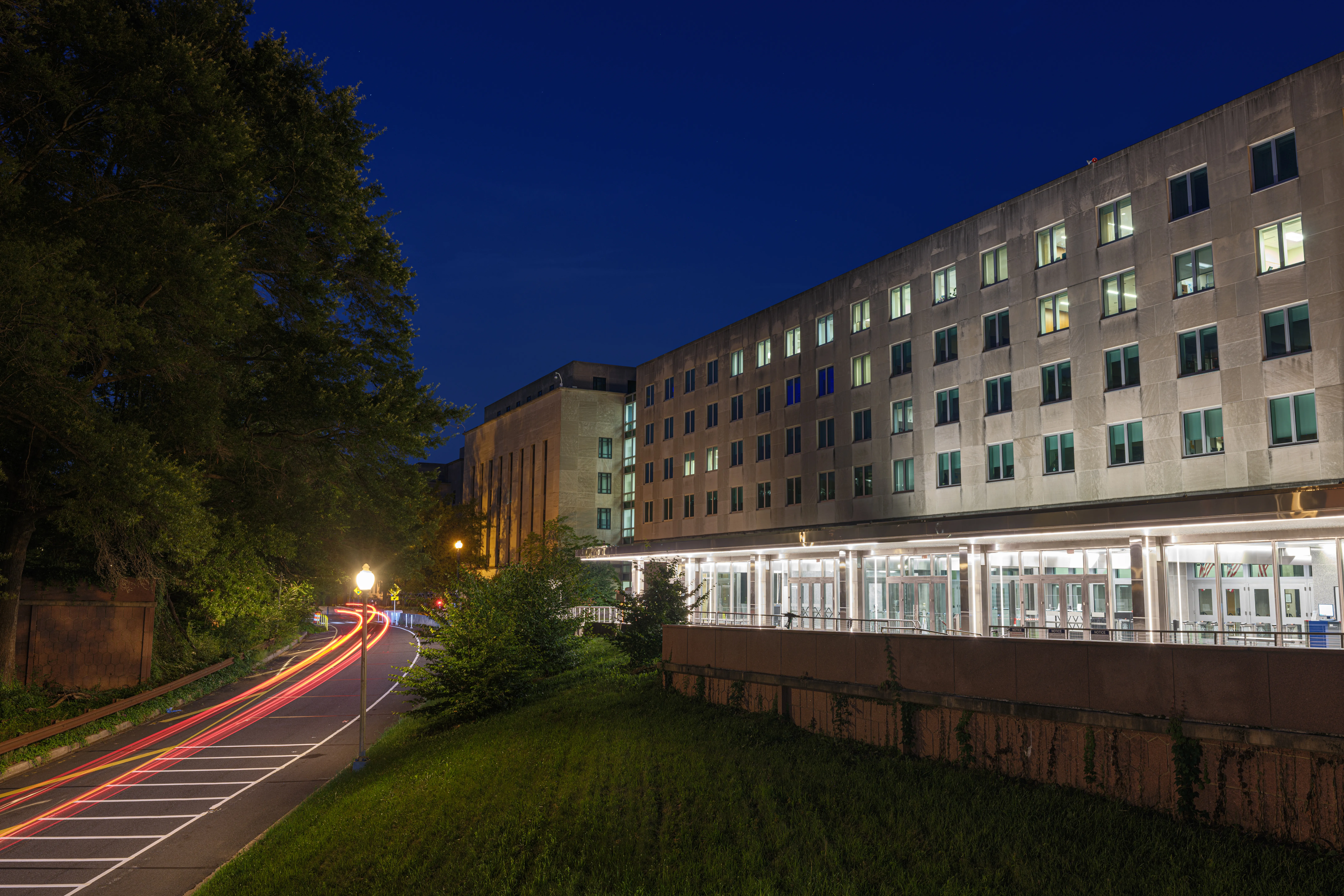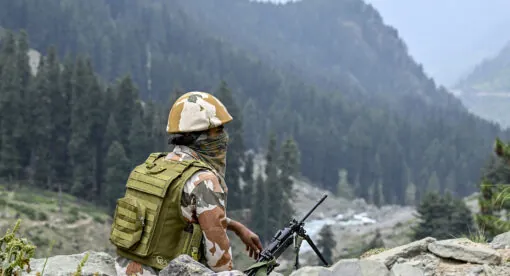The United States continues to experience high levels of social and political polarization resulting from the COVID-19 pandemic, its resulting economic downturn, and ongoing civil unrest. Both far-right and far-left extremists are exploiting these events to further their respective causes. The negative impacts of these shocks will likely intensify up to and past the Nov. 3 elections, into 2021. As a result, the country faces a growing risk of continued civil disturbance, including threats and acts of further political violence that strain limited law enforcement resources and further invite the potential for larger-scale violence.
Election Threat Assessment
The primary non-state threat to the American homeland continues to be far-right lone-actor and small-group violent extremists.
Violent far-right non-state actors include anti-government extremists such as supporters of the “Boogaloo” movement, white supremacists, members of the Proud Boys, and far-right armed vigilantes — the latter of whom have mobilized due to exaggerated or false fears about anti-fascist (antifa) or Black Lives Matter (BLM)-inspired looting and rioting. This is based on far-right extremists’ enduring violent intent and lethal capability, as exhibited in recent domestic terrorism and other ideologically motivated violent incidents such as the mass-casualty attacks in El Paso, Texas (2019), Pittsburgh (2018), Las Vegas (2017), Charlottesville (2017), Charleston (2015) and Oak Creek, Wisconsin (2012), as well as older bombings at Centennial Olympic Park in Atlanta (1996) and the Alfred P. Murrah building in Oklahoma City (1995). Violent far-right actors commonly possess firearms, are frequently educated in the use of guns and explosives, and are often trained in paramilitary and individual combat skills.

Many of these actors have prior (and sometimes current) service in military and first-responder agencies, including law enforcement — the result of years of sustained and often unchecked efforts to penetrate these entities. We remain concerned about far-right extremist ties to state and local law enforcement personnel, which raise concerns about police impartiality, fairness, and professionalism in many communities, especially minority ones, where trust in authorities is already strained.
As we pointed out in an earlier analysis, there have been several observed activities suggesting linkages between law enforcement and militia extremists and other far-right armed vigilantes. Activities include recruitment and infiltration of law enforcement, cooperation between officers and extremists, alleged coordination/partnership between officers and extremists, and officers providing information tip-offs to extremists. More recent examples include Kenosha County Sheriff’s deputies in Bearcat tactical vehicles providing bottled water and words of encouragement to a group of militia extremists during civil unrest in Wisconsin and a Clackamas County Sheriff deputy providing a bogus tipoff to armed vigilantes about unconfirmed antifa arson activity and looting during wildfires in Oregon.
At the moment, violent far-left extremists also pose a growing, although substantially lesser, ideologically motivated threat. These groups include anarchists, extremist strands of Black nationalism, and antifa. While far-right extremists are largely characterized by fatal attacks against people, violent behaviors from far-left extremists are largely characterized by non-fatal attacks, mostly against property and police. They tend to lack the same level of formal weapons training many far-right actors have, though there are disturbing signs that these trends may be shifting.
Far-Right Extremists
U.S. far-right extremists, like other ideologically motivated actors, are adaptive adversaries who learn from their past experiences and adjust to their surrounding socio-political environment to advance their goals. For several years, armed far-right actors have shown up in and around several types of civil unrest flashpoints, including, but not limited to:

Far-right entities have also organized and trained in a diverse array of modes, including forming fight clubs and stockpiling weapons (e.g. firearms, ammunition, explosives), and they have made recent calls to arms in anticipation of an impending societal collapse, often described by white supremacists as a coming “race war” or by anti-government extremists as a coming “civil war.” Far-right extremists have utilized a variety of social media platforms and other communications media to spread their message throughout the country and enhance their collective capability to mobilize supporters and recruit sympathizers. These communications-related capabilities have enhanced extremist propaganda efforts, networking, organizing, recruitment, and radicalization activities such as counterprotest mobilization, calls to arms, doxing, and making threatening communications.
More recently, in what appears to be a reaction to nationwide anti-racism protests, they have shown up to and in some cases organized counter-protests, called “flag rallies,” “Back the Blue” and other similar nomenclature. The narratives and message frames they use to mobilize their supporters and justify their actions are frequently couched in defensive terms. In addition to expressing support for law enforcement and protecting communities from feared criminal activity, anti-BLM/anti-antifa rhetoric is common at these events and is increasingly associated with attempts to harass and provoke physical confrontations with anti-racism protesters. For example, in advance of one recent rally in Denver, a far-right event organizer stated in a pair of tweets:
It’s time to Roll!
BLM, Antifa, and related Marxist associations are assaulting everything we love and cherish about this country. Their narrative supports ‘dismantling’ the system… which leads to anarchy. Anarchy in our streets leaves good citizens to be attacked or harassed while eating in restaurants, driving to work or home, or walking down the street. Are you tired of these self-righteous participation trophy punk-ass kids destroying your state, city, town and neighborhood? Come join fellow patriots and let’s be heard and seen!
Far-right extremists are showing up to anti-racism protests and counter-protests defiant, armed, and confrontational. Like the messages expressed at flag rallies and Back the Blue events, the rhetoric used when counter-protesting is also frequently couched in defensive terms. Many of these actors, such as anti-government extremists and ad hoc vigilante groups, claim to be engaging in a necessary exercise of their constitutional rights (namely the right to bear arms), to defend law and order in their communities. Combined with rapidly spreading disinformation online, civil disturbance, property destruction, clashes between police and protesters, and looting — however limited that may be in proportion to the overall size and scope of nationwide anti-racism protests — reinforces far-right extremists’ notion that a civil war or race war is imminent. Witnessing societal deterioration during violent protests, whether via media outlets or in person, energizes their warrior mentality and stockpiling activities and furthers the eschatological elements of their rhetoric.
The fatal shooting of Aaron Jay Danielson in Portland is a case in point. Danielson, a supporter of the far-right group Patriot Prayer, has become a galvanizing moment for several far-right extremists, some using it as a rally cry for violent retaliation. On Twitter, Stewart Rhodes, national leader of the anti-government extremist group Oath Keepers, called for retribution for the Portland shooting, characterizing it as “the first shot has been fired … civil war is here, right now.” Chris Hill, national leader of the Three Percent Security Force, stated on social media, “this is the inflection point, it’s where the pendulum swings back in the other direction … free people have the right to push back against this … terrorism.” Danielson, who allegedly was killed by a self-declared antifa supporter, has the potential to grow into a martyr-like figure for far-right extremists. This in turn could motivate disillusioned militia extremists and disaffected armed vigilantes to plot and carry out acts of violence against BLM, antifa, or others perceived as left-wing terrorists.
Far-Left Extremists
Violent far-left actors continue to use improvised weapons such as commercial fireworks, modified shields and helmets, improvised flame-throwers, and Molotov cocktails — as well as, increasingly, firearms — at BLM and social justice protests. Historically, their intent is not to harm civilians but to cause civil disturbance, attack the police, and engage in property destruction. However, recent examples of violence against far-right actors like the shooting of Danielson and the stabbing of Andrew Duncomb, as well as the attempted arson of a Seattle Police Department building with officers barricaded inside and a car ramming attack against a crowd of right-wing counter-protesters in Yorba Linda, California, by a fringe supporter of Black Lives Matter, suggest far-left extremists are increasingly willing to attack perceived enemies, with potentially fatal consequences. These actors have also been following a strategy of dispersing disturbances across a wide geography in a given city as a means of straining law enforcement bandwidth.
We assess that the prolonged civil unrest in urban areas, specifically Minneapolis, Portland, Seattle, Oakland, and San Francisco, has become a blueprint for violent anarchists, actors embracing extremist strands of Black nationalism, and violent antifa supporters elsewhere who export their narratives encouraging violence to other locations throughout the country. Like their far-right extremist counterparts, violent far-left extremists are actively propagating violent narratives and building online support networks to enable and encourage local actors to engage in attacks.
Over the past few weeks, there have been an increasing number of physical confrontations and street brawls between protesters and counter-protesters, many of whom are in possession of firearms while at these political assemblies. This mounting tension between opposing actors increases the likelihood of violent retribution, resembling a “street war.” Below is an illustrative list of these flashpoints:

The federal law enforcement response to the Portland protests in July and August, coupled with the Trump administration’s stated intent to designate antifa a terrorist group, served as reinforcing the far-left’s perceptions of social injustice, a militarized police, and biased government scrutiny. According to a recent report by the Armed Conflict Location & Event Data Project (ACLED), “after the deployment of Homeland Security agents in Portland, the percentage of violent demonstrations has risen from under 17% to over 42%.”
The tough-handed tactics have evoked a loose comparison by at least one high-profile commentator to measures deployed during the 1992 Ruby Ridge, Idaho, and 1993 Waco, Texas, standoffs. The comparison is far from perfect for many reasons, especially given that those cases involved armed far-right actors, while in Portland they involve mostly unarmed non-violent protesters that include but are not limited to far-leftists. Yet they appear to have similar effects insofar as earning public scorn, reinforcing narratives expressing mistrust of authorities, fear of a police state, and violently escalating delicate circumstances. These actions only reinforce violent far-leftists’ negative views of the police and criminal justice system.
Similarly, BLM protesters shot by militia extremists in Albuquerque and Kenosha (and an apparent vigilante in Austin), as well as the murky circumstances surrounding the killing of Portland shooting suspect Michael Forest Reinoehl (an alleged antifa or antifa-inspired actor) by police, may serve as potential martyr-like figures for the far left. Violent far-left extremists could be motivated to retaliate against far-right counter-protesters in retaliation on behalf of these victims. Potential retribution attacks could escalate into an ongoing conflict, resulting in injuries and fatalities.
Forecast
Through the remainder of 2020 and into the first quarter of 2021, we expect both far-right and far-left extremists to continue their recruiting and radicalization activities.
There are other exacerbating variables to consider:
- Escalating tensions associated with the 2020 presidential election,
- A projected second wave of coronavirus infections that may roll back reopening the economy
- The likelihood of additional disinformation efforts seeking to instigate and exploit socio-political polarization
- Mounting tensions and violent confrontations between protesters — both left and right — directly associated with ongoing civil unrest throughout the country.
2020 Elections
To say that the 2020 U.S. presidential election is filled with tension and anxiety would be an understatement. The recent death of U.S. Supreme Court Justice Ruth Bader Ginsberg, which creates a third U.S. Supreme Court vacancy in the past four years, further elevates the importance of an already high-stakes election year. The election process itself is likely to be prolonged due to increased use of mail-in ballots, lowered in-person voter turnout due to the ongoing pandemic, and accusations of voter fraud, among other factors. There is also the potential for legal battles over vote counts that could push the final election results into next year. This, in turn, could aggravate wider political tensions in the United States, including between far-right and far-left actors, further resulting in escalated or deadlier violence.
Armed anti-government extremists have been actively organizing and participating in anti-lockdown protests, rallies to reopen the economy, BLM counter-protests, and related civil unrest. Some have gone further to attempt acts of violence. For example, a group of 13 militia extremists were recently arrested in Michigan for plotting to kidnap Gov. Gretchen Whitmer and attack state police. Other far-right actors, such as the neo-fascist Proud Boys, have been energized by President Donald Trump’s rhetoric during the Sept. 29 presidential debate to “stand back and stand by.” Any serious allegations by current administration officials concerning voter fraud or a rigged election could incite militia extremists toward violent actions. Similarly, any attempts by Democratic leadership to remove the current president of the United States in the case of a Republican loss will be interpreted by some militia extremists as an illegitimate and hostile action, thus justifying a likely violent response.
COVID-19
Responses to COVID-19, including stay-at-home orders, social distancing measures, and mask wearing, will remain muddled. While some governmental actors will continue to encourage and enforce public health measures until a viable coronavirus vaccine is mass-produced and administered throughout the country, others will continue to downplay the importance of, or openly flout, these measures.
Far-right actors — often due to economic considerations, perceptions their liberties are being infringed upon, and/or consuming pseudo-scientific disinformation — have been particularly vocal about opposing these public health measures. Though it does appear that far-right actors’ attention and energies have shifted as of late toward counter-mobilizing against BLM and antifa, we have not seen any recent signs of softened opposition to COVID-related public health measures. In fact, it may re-intensify, as far-right actors are reportedly reacting positively to the defiant and triumphant tone Trump has set for himself since returning to the White House after visiting Walter Reed Hospital when he contracted COVID-19. In light of these factors, we believe this will fuel continued far-right extremist recruitment, planning, and participation at rallies and protests against government regulations and health measures.
Disinformation Efforts
Disinformation was prevalent during the nationwide anti-racism protests, particularly over social media. For example, there were social media-spread rumors that antifa and Black Lives Matter were plotting to riot and loot in predominantly white rural and suburban towns, which caused panic in many communities and led to the formation of armed vigilante groups. Cases like that and others led us to conclude, at the time, that the United States is in a heightened state of vulnerability to the effects of disinformation efforts that can worsen already-significant socio-political polarization.
Recent events led us to sustain this judgement. For example, recently unsubstantiated rumors over social media have spread claiming that antifa is responsible for setting wildfires that spread in Oregon. These claims have been amplified by, among others, supporters of the far-right conspiratorial movement QAnon as well as Russian state-controlled media outlet RT. News outlets reported that first-responder agencies have spent much of their limited time and resources responding to disinformation rather than the fires themselves. Like the earlier false BLM- and antifa-related rumors about rioting, some communities also formed vigilante groups that have created “checkpoints and are stopping cars.”
It is also worthwhile to point out that some versions of these rumors have also claimed that the far-right group Proud Boys was responsible for starting the fires. This is important to note because it suggests, like earlier efforts from actors such as the Russian government-connected Internet Research Agency, disinformation may be targeted toward and/or circulating in left-leaning political communities, too.
Regardless of the target audience, we can reasonably expect that disinformation efforts, whether foreign or domestic, will continue to take advantage of the current socio-political climate and periodically intensify around “trigger” events including natural or man-made disasters, or events of social symbolic or political significance, such as Election Day.
Far-Left/Far-Right Radicalization
Sporadic yet persistent, BLM protests and resulting civil unrest stemming from the high-profile killings of Black Americans by police officers has and will continue through the 2020 national election cycle. For this reason, we anticipate far-right extremists will continue to hold armed counter-protests at BLM rallies; guard businesses against vandalism, arson, and looting; conduct armed patrols in towns and communities; and attempt to forge bonds between concerned citizens, business owners, and local law enforcement in some jurisdictions.

Armed far-left extremists, such as the Not F***ing Around Coalition and Redneck Revolt/John Brown Gun Clubs, are organizing and increasing their presence at political gatherings, rallies, and protests. This inevitably raises tensions among competing extremist groups, thus elevating the potential for lethal violence, whether intended or not. It may also have a similar effect to an arms race between two opposing sets of actors. Further, the presence of armed protesters and armed counter-protesters increases the likelihood of an accidental or intentional discharge of firearms resulting in injuries or death — or worse, setting off a chain reaction leading to a firefight between armed opponents.
Recommendations
Elected officials and law enforcement agencies need to comprehensively condemn any and all unlawful ideologically motivated violence, irrespective of any particular actor’s politics. Doing so is factually accurate, presents a unified front against violence and terrorism, and, where relevant, will hopefully act as important step toward restoring oft-fractured trust between the police, government officials at all levels, and the citizens they serve.
Consider banning all weapons (especially firearms, ammunition, fireworks, and other explosive and incendiary devices) from future rallies and protests. Comprehensively surveying local and state laws, as well as federal court case precedent, an April 2018 article published in the UCLA Law Review found that “state and local officials have significant latitude to enact and enforce laws that restrict the intimidating display of firearms at public demonstrations. Instead of inhibiting constitutional rights, these laws protect people’s rights to speak freely and to peaceably assemble.” There should be no weapons at protests, which tend to bring together strong, often heated opposing views among various protest and counter-protest groups. Against the backdrop of increasing armed extremist presence at protests/rallies, such measures would substantially reduce the risk of lethal encounters and acts of mass violence. Moreover from a First Amendment perspective, it would also address concerns about “chilling effects” many believe to be associated with bringing weapons to public assemblies exercising the constitutional right to freedom of expression.
Localities facing situations where hosting otherwise lawful assemblies may attract a likelihood of violence are urged to adopt protocols that ensure public safety while upholding constitutional freedoms of peaceable assembly and expression. This includes a range of research-informed “best practices” that emphasize clear protocols for constitutionally consistent policing of protests/rallies, clear and effective communication with protest/counter-protest organizers and attendees, ongoing dialogue with local community stakeholders, “stadium-style” security measures that include the creation of secure perimeters and buffer zones between opposing factions, and appropriate information-sharing and coordination between various local, state, and federal law enforcement entities, including, in applicable cases, the National Guard. On this latter point, given recent evidence suggesting that certain types of federal interventions into otherwise peaceful protests have been associated with a greater likelihood of violence, federal law enforcement actors, including the National Guard, should augment state and local law enforcement, not operate autonomously. Collectively, these kinds of measures can decrease the risk of violent confrontations between opposing groups, enable working relationships with both sets of protesters, create the basis for trust-building with the local community impacted by the protests, and prevent potentially volatile situations from escalating further.
Federal, state, and local law enforcement, their decision makers, and elected officials need to prepare for a prolonged period of violence, domestic terrorism, and civil disturbance lasting into 2021. Again, we expect a tumultuous, highly contested election in November that will likely extend beyond the normal election cycle due to prolonged vote counts and likely legal action contesting votes at key localities. In turn, these factors could contribute to increased levels of anxiety, paranoia, and frustration among extremists, some of whom may mobilize toward violence as a result. Intelligence, security, and law enforcement resources should be mobilized as needed to supplement other agencies that are experiencing surges in civil disturbance, criminal activity, and violence, much like the health care sector mobilized doctors and nurses to pandemic hotspots.
To the extent it occurs, law enforcement entities must take great care and caution in how they engage with far-right extremists. As we and others have found, in recent months there have been several incidents of law enforcement officers engaging far-right actors in a favorable manner, rather than in an impartial and professional one. There has also been growing concern about the presence of far-right extremists in law enforcement ranks and how they have a potentially negative impact on policing practices. Armed militia members and other far-right vigilantes are extremists, many of whom use their right to freedom of expression to advocate for or condone illicit and violent actions. Some of these actors also embrace hatred of other races, ethnicities, and faith-based communities such as Muslims and Jews, or express xenophobic attitudes toward immigrants. Even if their intent was benign or unintentional, behaviors such as photo ops, expressions of gratitude, disparate treatment, and friendliness shown by police officers towards militia members and vigilantes send the wrong message by undermining public trust and enabling, emboldening, and ultimately strengthening extremism. We reiterate our earlier call to remove extremists from the ranks of law enforcement or, if that is not possible, at least take additional administrative and other departmental policy steps to mitigate any potential negative impacts their presence may have. America’s law enforcement and judicial system must show equality, objectivity, and respect to everyone they serve.
Alejandro J. Beutel is a nonresident fellow with the Newlines Institute who studies non-violent and violent far-right extremist and Islamist movements. Beutel is a former Senior Research Analyst at the Southern Poverty Law Center and a former Researcher for Countering Violent Extremism at the University of Maryland’s National Consortium for the Study of & Responses to Terrorism. He is a doctoral candidate in Criminology at the University of Massachusetts at Lowell.
Daryl Johnson is one of the foremost experts on domestic extremist groups in the United States and a nonresident fellow with the Newlines Institute. Beginning his career as a civilian in the U.S. Army, Johnson has held a number of government positions, most recently as senior analyst at the Department of Homeland Security. He is also regularly cited, featured, or quoted in media covering domestic extremist groups in the United States, including the New York Times, Washington Post, Wall Street Journal, Newsweek, National Public Radio, MSNBC, CNN, and NBC Nightly News, among many others. He is the author of “Hateland: A Long, Hard Look at America’s Extremist Heart” (Prometheus Books, 2019) and “Right-Wing Resurgence: How a Domestic Terrorism Threat Is Being Ignored” (Rowman & Littlefield, 2012).
The views expressed in this article are those of the author and not an official policy or position of the Newlines Institute.

